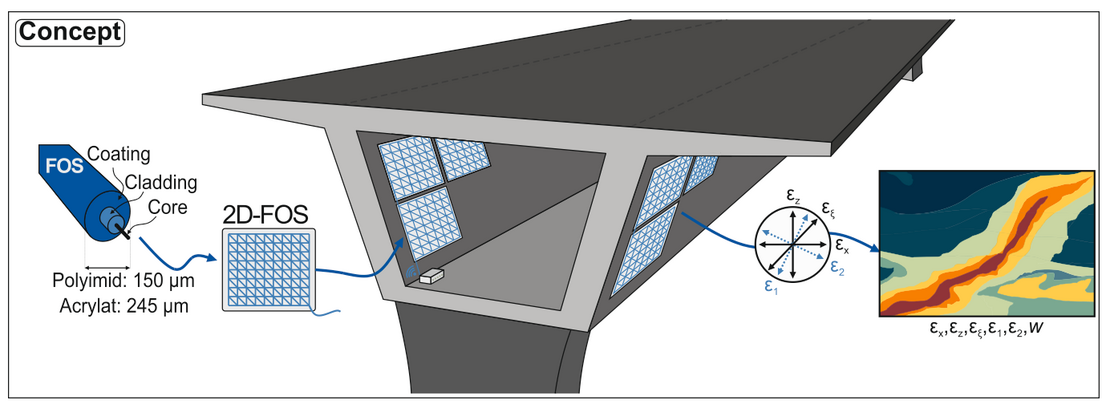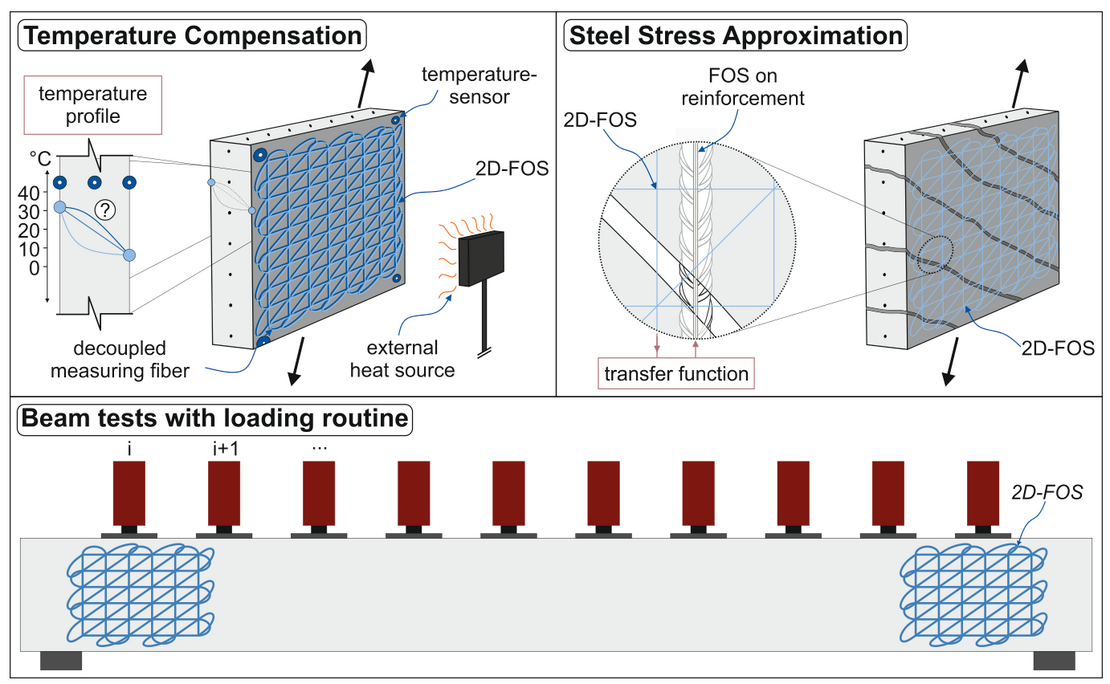Measurement-based condition assessment, load identification, and service life prediction of prestressed concrete bridges with low shear reinforcement using the 2D-FOS method
Germany’s infrastructure is aging and exposed to continuously increasing traffic loads. Since rapid replacement of thousands of bridges poses a major challenge, preserving existing structures is of crucial importance. A large share of older bridges consists of prestressed concrete, designed for combined shear, torsion, and bending loads based on principal stresses. These bridges therefore exhibit high prestress levels but comparatively little conventional reinforcement. If deficiencies are identified during structural assessments or visual inspections, they often result in downgrading to a lower load class or taken out of service.
However, current knowledge shows that both static and cyclic loads can still be carried for many years even after the formation of macrocracks with limited crack widths. These reserve capacities currently remain unused due to a lack of continuous information on time-dependent structural behavior and reliable methods for predicting the remaining service life.
To safely utilize these reserves and to precisely evaluate the condition of such structures, a novel measurement concept – 2D-FOS – was developed at the Institute of Structural Concrete (IMB) during the first project period (Project B01/C01). It is based on the surface-mounted, mesh-like application of two-dimensionally arranged fibre optic sensors and enables high-resolution measurement of two-dimensional strain and crack fields.
The aim of the second project period is to build upon the obtained results and develop an integrated monitoring concept that enables identification of the time-variant structural condition, analysis of applied loads, and reliable prediction of the remaining service life of existing prestressed concrete bridges based on continuously acquired measurement data.

The developed concept envisions the application of a fibre optic sensor network in particularly stressed areas of the structure. As part of the first project period, its suitability for recording fatigue-relevant strains was investigated experimentally. The results show that two-dimensional strain fields can be precisely recorded and evaluated with the help of the sensor network. Building on this, automated crack detection, crack width evaluation, and visualization of two-dimensional crack patterns under static and cyclic loading are possible.
To further improve data quality, several approaches for temperature compensation of the measured strains are investigated. Experimental tests are conducted on tensile specimens subjected to combined thermal and mechanical loading. For fully automated service-life prediction, continuous determination of reinforcement stresses using the fibre optic sensor network is also essential. Using additional reinforced tensile specimens, a relationship between surface-measured crack width and the resulting fatigue-relevant stress range in the reinforcement is established.

Another objective of the research project is the development of a novel method to identify traffic loads on bridges using the 2D-FOS sensor network. The sensor network is calibrated so that characteristic strain profiles (“fingerprints”) of individual vehicle crossings are recorded and used to determine the acting traffic loads and load spectra. Experimental calibration is carried out on reinforced- and prestressed-concrete beams loaded by individually controllable hydraulic cylinders arranged along the beam axis. This allows realistic simulation of vehicle crossings with varying loads, speeds, and load spectra, and systematic analysis of the resulting strain characteristics.
To reliably and automatically estimate the remaining service life of existing structures based on fibre optic strain data, innovative prediction models are developed and integrated into existing evaluation algorithms. For reinforced and prestressed concrete structures, remaining service life can be divided into two phases: service life up to crack initiation (State I) and service life after cracking (State II). The transition from State I to State II occurs when the concrete tensile strength in the critical region is exceeded, resulting in macrocrack formation and activation of the reinforcement. Therefore, the proposed prediction models rely on fatigue-related damage mechanisms in both states.
Prediction in State I is based solely on the nearly linear strain increase during the second phase of the three-phase fatigue-creep curve, whose clear relationship to the maximum number of load cycles has been demonstrated in several studies. Prediction of remaining service life in State II is based on the experimentally established relationship between the calculated crack width and stress range in the reinforcement, and on the linear damage accumulation hypothesis according to Palmgren-Miner.

For final calibration and validation, test beams are examined under static, cyclic, and thermal loading. The geometry, reinforcement ratio, prestress level, and concrete strength are based on real prestressed concrete box girder bridges. To verify the 2D-FOS results, strain development is simultaneously monitored using digital image correlation in all tests. Additionally, the system will be tested under real operating conditions. Applications of the 2D-FOS system are planned on the Nibelungen Bridge in Worms and the openLAB research bridge.
Team
Publications
First period:
Peer-Reviewed Journal Paper:
Janiak, T.; Becks, H.; Camps, B. et al.: Evaluation of distributed fibre optic sensors in structural concrete. In: Materials and Structures, Vol. 56 (2023), Iss. 159. doi.org/10.1617/s11527-023-02222-9
Becks, H.; Lippold, L.; Winkler, P. et al.: Neuartige Konzepte für die Zustandsüberwachung und -analyse von Brückenbauwerken – Einblicke in das Forschungsvorhaben SPP100+. In: Bauingenieur 99 (2024), Heft 10, S. 327-338. doi.org/10.37544/0005-6650-2024-10-63
Becks, H.; Högemann, M.; Hegger, J. et al. : Assessing crack formation and strain distribution in concrete structures using externally installed fiber optic sensors. In: Case Studies in Construction Materials (2025). doi.org/10.1016/j.cscm.2025.e04744
Konferenz und andere VÖ:
Becks, H.; Brockmann, D.; Hegger, J. et al.: Monitoring the Fatigue‐Induced Strain Evolution of Concrete Bridges using Fiber Optic Sensors. In: ce/papers (EuroStruct 2023, Vienna), Vol. 6 (2023), Iss. 5, pp. 1119-1126. doi.org/10.1002/cepa.2033
Becks, H.; Hegger, J.; Classen, M.: Measuring Strain and Crack Evolution in Reinforced Concrete under Monotonic and Fatigue Tension using Fiber Optic Sensors. In: Procedia Structural Integrity (SMAR2024, Salerno) Vol. 64 (2024), pp. 1279–1286. doi.org/10.1016/j.prostr.2024.09.197
Becks, H.; Hegger, J.; Classen, M.: Two-dimensional strain measurement and crack detection of reinforced concrete using fiber optic sensors. In: IABSE Congress Ghent – The Essence of Structural Engineering for Society Vol. 25 (2025), pp. 480-489. doi.org/10.2749/ghent.2025.0480





